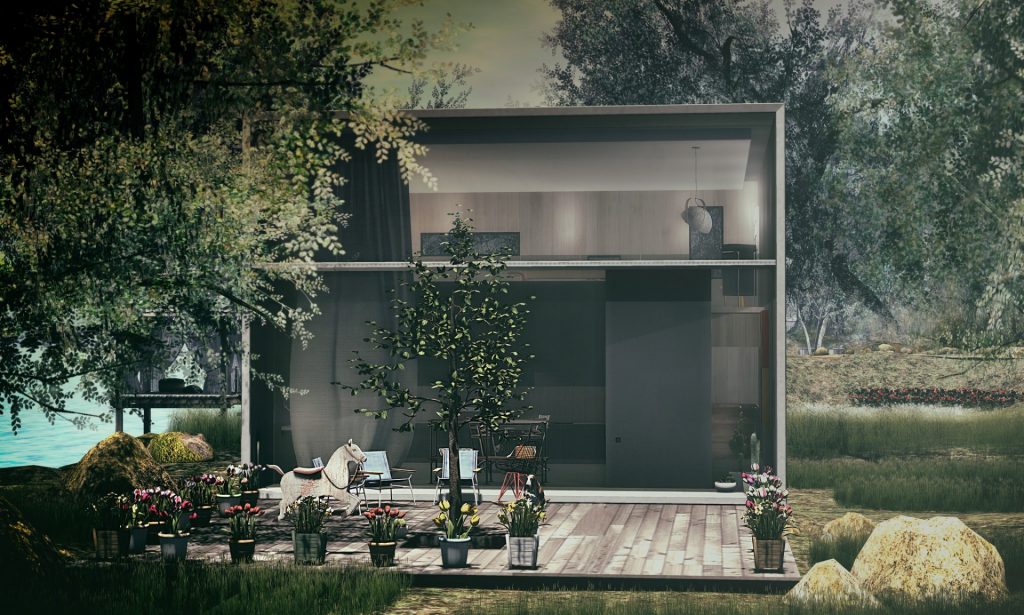How To Trade Up To Your Dream Home in Las Vegas
 For families with growing kids, a starter home can soon begin to feel cramped. Yet if you have ventured out into the housing market recently, you may have noticed that it’s feeling a squeeze as well, with strains on supply and a resulting increase in prices.
For families with growing kids, a starter home can soon begin to feel cramped. Yet if you have ventured out into the housing market recently, you may have noticed that it’s feeling a squeeze as well, with strains on supply and a resulting increase in prices.
Trade up is to trade something in for something more expensive or valuable of its kind. Trading up a house is what people do when they already own a home but want to move to one that is bigger or in a different neighborhood. The basic concept is simple: Use the equity you have built in your current home to help you finance a more expensive home. The practical details of buying a home while you’re selling a home can be tricky, but there are ways to do it without despair. Particularly, there are three popular ways you can trade up houses. You can sell your current house first, you can have the buyer assume your mortgage, or you can buy your new house before selling the old one.
But how do you know that you are ready to trade up?
Before you start trading up your house, you should learn all the expenses of the whole processes. If we were to look at it like math’s, it would look something like this: (Trade Up Home Costs – Current Home Costs) + (Down Payment – Proceeds from Sale) = Estimated Cost to Trade Up. It sounds easier than it really is, so we will be breaking it down for you below.
So, what are trade up home costs including?
Mortgage Payment
Pull up your most recent mortgage payment to verify your current payment and use a mortgage calculator to estimate the payment on a more expensive property. Don’t underestimate the importance of mortgage interest rates in your calculations.
Property Tax
Nevada’s property tax rates are relatively low. The state’s average effective property tax rate is 0.96%. Your real estate agent is the best resource for accurate estimates on property tax since they know the areas where you’re selling and buying. The average property tax rate for the state is lower than the national average.
Income Tax
Lucky you! Nevada has no state income tax. Nevada is one of nine states that do not tax income on individuals, and one of six which does not tax income on corporations, according to the U.S. Census Bureau. Nevada generates revenue mainly through property and sales taxes.
Utilities
Utilities you should take into account include: electricity, gas, water, sewer, and trash and recycling. Each municipality contracts with providers differently, so check their websites or ask your real estate agent for utility costs specific to your area. Investing in energy efficiency can save you money on utilities over time and may qualify you for tax credits. Some of the categories the IRS gives credits for are:
- Appliances
- Insulation, windows, and heating and air conditioning
- Solar, wind, geothermal, and fuel cell systems
Homeowner’s Insurance
As with utilities, the cost of your homeowner’s insurance on a trade up will be specific to your new home and can be estimated using your new home’s square footage. Here is a quick formula to provide you with an estimate. Complete it to determine your new payments:
Current Homeowner’s Insurance X % of Increase in Square Footage = New Homeowner’s Insurance Costs
Shop around for homeowner’s insurance. Get at least three quotes and take into consideration policy price, coverage, and customer service reviews. Also, your current insurance company may offer a discount for carrying multiple policies with them. If you install a central monitoring security system, most insurance companies will give you a discount on your homeowner’s rates. Be aware, however, that this discount won’t pay you back for the monthly costs of the system. In general, install the security system if you’re looking for peace of mind and take the discount as an added bonus.
Maintenance
The cost of upkeep on a new home – trade up or otherwise – is one of the trickiest numbers to get right. You won’t know the condition of the new home or its added features until you’ve had it inspected. In the meantime, assume that your maintenance costs will increase and use the following calculation to estimate a number for your budget:
Target Purchase Price of New Home X 1% = New Home Maintenance
If you’re in search of an older or historic home, use 1.25% – 1.5% for your estimate.
Now you may have an idea of how much trading up would cost. Compare your Estimated Cost to Trade Up to the savings you have available. If you’ve experienced a recent windfall or have been stashing away savings, the cost to trade up could be manageable.
Here are the most popular options for you to make as you think about selling your current house and searching for more legroom.
Sell Your House First
Even in the current seller’s market, financial advisers recommend that you sell your existing place first. In different circumstances you might have been able to make an offer on a new home dependent on the sale of your current place, but now? You want as few contingencies as possible.
If you wind up having to rent for a few months, experts say, that’s better than juggling two mortgages. The good news: While there are always exceptions, you should be able to sell quickly. Just continue to shop around while you’re marketing your home so you can move quickly to bid on your next place.
Put your home on the market.
The easiest way to do this is to contact a real estate agent. The agent will come and look at your house and ask you to fill out a disclosure form listing any problems you know about with the home. They will likely suggest a listing price for the home, take pictures of the home, and arrange for showings to potential buyers.
Don’t Overprice.
With all this talk of supply constraints, you might be tempted to add a little extra onto your asking price, just to give yourself more purchasing power when it’s time to make an offer on your next place.
Resist: As a trade-up buyer, you’ll need flexibility as well as a high price, so your primary goal should be to draw multiple bids—which, in turn, will give you more room to negotiate your exit. You want to be no more than 1% to 2% higher than comparable. Buyers know if something is priced too high, and the house will sit. To find comps, ask your agent for several sales from the last two to six months. Make sure properties are as similar as possible to your own and be sure to zero in on the final deal prices, not list prices. Price the house perfectly and you improve your odds of getting multiple offers.
Look at New Home Developments
Begin looking for homes in the area where you are intending to move so you can get an idea of how quickly homes in that area are selling and at what price and be prepared when the time comes to buy your new home.
Most new developments are sold on a first-come, first-served basis. That’s a different buying process, which tends to have a longer time frame and can simplify the trade-up buyer’s high-wire act. There are no bidding wars. You’ll need to pay a deposit upfront—figure 1% to 2% of the purchase price—but the balance won’t be due until you close on your mortgage, typically when the home is near completion. That gives you time to sell your current house.
Accept an offer on your current home.
If the housing market is hot, this can happen quickly. You may have multiple offers for your home. Take the best offer. This might sound simple, but you’d be surprised how many people hold on and don’t make a final decision before it’s too late.
Rent a storage for your belongings
Arrange to put your belongings in storage until you can buy your new house. In most cases, you will want to hire movers to make the process easier, although it is cheaper to handle the move yourself with some friends or family members and a rented truck.
Rent a home until you buy a new home.
If you think this will be a long period of time-based on your understanding of the market in the area where you are looking to buy, you can skip the previous step and take a long-term rental using your own furniture. However, in most cases, getting a furnished rental for a month or two is sufficient. Alternatively, you can stay with friends or family.
Put an offer on a new house.
Once it has been accepted, you can make arrangements to move your family and belongings into your new home.
Mortgage Assumption
Put your house on the market, again using a real estate agent.
Using a real estate agent cuts all the hassle when compared doing it all on your own.
Contact your lender to see if your mortgage is assumable.
If the market is slow in your area, you might be better off listing your home with the notation that you are willing to let the buyer assume your mortgage.
Ask prospective buyers if they are interested in assuming your mortgage.
Their willingness to do so might depend on how much of a mortgage you are carrying. If they agree, they will have to find financing for the difference between the balance of the mortgage and the selling price. For example, if the selling price of the home is $200,000 and your mortgage balance is $150,000, they will need to find financing for the difference of $50,000.
Inform your lender
Inform them that you have prospective buyers who are interested in assuming the mortgage. The lender will provide them with an application and a list of required supporting documents to submit. As for any other loan, buyers will need to prove that they are creditworthy; but the approval requirements for a loan assumption are generally lower than those for a conventional mortgage.
Talk to your buyers
Ask the buyers to arrange for financing for the difference between the mortgage balance and the selling price. They can be working on this with their own lender while your lender is processing their application to assume the mortgage.
Sign the papers from your lender transferring the mortgage to the buyers.
Accept payment for the difference between the mortgage amount and the selling price.
Move out of your home and into a rental or other short-term housing while you begin the process of purchasing your new home.
Buy the New Home First
Look for homes
Look around in the neighborhood where you want to move. Determine an average price for the size of home you want so you know how large a loan you will need. New developments are still your greatest options here.
Contact your current lender — or a new lender (if you find one offering better rates)
Arrange to get pre-qualified for a new home loan. To do so, you will need to demonstrate creditworthiness and the ability to pay the new mortgage as well as your current mortgage.
Coordinating the old mortgage and the new mortgage is difficult, and it’s recommended that you have an experienced real estate agent to help you through the process.
Make an offer on a new home
This process can take some time, as the house will need to be appraised and inspected before you can finalize a purchase. However, in hot real estate markets, the seller might get several bids as soon as the house goes on the market, so be prepared to make an offer on a home if you want it.
Sign the loan papers to purchase the new home
Your real estate agent and lender can guide you through each document, but it is essential that you read each page carefully and be sure you understand it before you sign.
Decide if you want to sell your home or rent it out
Even if you intend to sell the home, if the market in your area is slow, it may be wiser to rent it out for a year or two until the market improves and you can get a better price for the home.
List your current home with a real estate agent and have her photograph your home.
Move your belongings to your new home.
Top 5 Mistakes to Avoid When Trading Up to a Larger Home
Now that you know all the corrects steps to Trade Up to your dream home, let’s take a look and emphasize the top 5 most popular mistakes to ensure they don’t hinder your journey.
Unlike the experience of buying a first home, when you’re looking to move-up, and already own a home, there are many factors that can complicate the situation. It’s very important for you to understand these issues before you list your home for sale.
Not only is there the issue of financing to consider, but you also have to sell your present home at exactly the right time in order to avoid either the financial burden of owning two homes or, just as bad, the dilemma of having no place to live during the gap between closings. This is the worst case, and we don’t want that to happen!
Below, we’ve outlined the five most common mistakes homeowners make when trading up and moving to a larger home. Some may coincide with the tips shared above so remember them and understand the strategies to overcome them. Ultimately, it will help you make informed choices before you put your existing home on the market.
#1: Heart-shaped glasses
Most of us dream of improving our lifestyle and moving to a larger home. The problem is that there’s sometimes a discrepancy between our hearts and our bank accounts. You drive by a home that you fall in love with only to find that it’s already sold or that it’s more than what you are willing to pay. Most homeowners get caught in this hit or miss strategy of house hunting when there’s a much easier way of going about the process. Information will take the guesswork away and it will help to put you in the home of your dreams.
Look into cross-matching your criteria with ALL available homes on the market find a way to keep this information updated on an on-going basis. A good real estate agent can help you take off their heart-shaped glasses and move into the home of their dreams in an affordable way.
#2: Failing to make necessary improvements
If you want to get the best price for the home you’re selling, there will certainly be things you can do to enhance it in a prospective buyer’s eyes. These fix-ups don’t necessarily have to be expensive. But even if you do have to make a minor investment, it will often come back to you ten-fold in the price you are able to get when you sell. It’s very important that these improvements be made before you put your home on the market.
#3: Not selling first
You should plan to sell before you buy. This way you will not find yourself at a disadvantage at the negotiating table, feeling pressured to accept an offer that is below-market value because you have to meet a purchase deadline. If you’ve already sold your home, you can buy your next one with no strings attached. If you do get a tempting offer on your home but haven’t made significant headway on finding your next home, you might want to put in a contingency clause in the sale contract which gives you a reasonable time to find a home to buy. If the market is slow and you find your home is not selling as quickly as you anticipated, another option could be renting your home and putting it up on the market later – particularly if you are selling a smaller, starter home.
#4: Failing to get a pre-approved mortgage
Pre-approval is a very simple process that many homeowners fail to do. While it doesn’t cost or obligate you to anything, pre-approval gives you a significant advantage when you put an offer on the home you want to purchase because you know exactly how much house you can afford, and you already have the green light from your lending institution. With a pre-approved mortgage, your offer will be viewed far more favorably by a seller – sometimes even if it’s a little lower than another offer that’s contingent on financing. Don’t fail to take this important step.
#5: Failing to coordinate closings
With two major transactions to coordinate together and all the people involved such as mortgage experts, appraisers, lawyers, loan officers, title company representatives, home inspectors or pest inspectors the chances of mix-ups and miscommunication go up dramatically. To avoid a logistical nightmare, get a good agent who will work to carefully coordinate all the major and minor details of your transaction and closing.
Last but not least, a Tip: Don’t Snub the Suburbs
Across the board, Americans have been migrating back into urban areas since the recovery began years ago, according to U.S. Census data. Research company Nielsen has found that Millennials, in particular, are living in cities at a higher rate than any other generation and intend to stay there. You should head in the opposite direction, though—not for the schools and legroom, as previous generations did, but for the bargains. Since January 2010, the average price per square foot in the urban cores of 32 metro areas has increased 10.6% a year, according to Redfin, vs. 6.3% for the overall metro areas.


